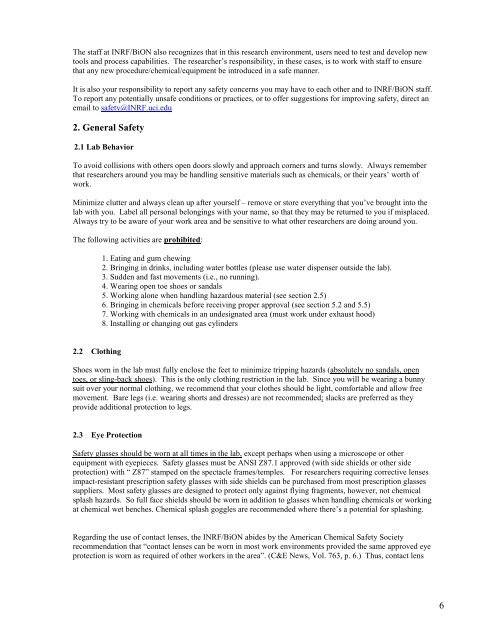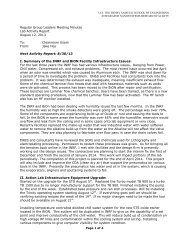Download Lab Safety Manual - Integrated Nanosystems Research ...
Download Lab Safety Manual - Integrated Nanosystems Research ...
Download Lab Safety Manual - Integrated Nanosystems Research ...
Create successful ePaper yourself
Turn your PDF publications into a flip-book with our unique Google optimized e-Paper software.
The staff at INRF/BiON also recognizes that in this research environment, users need to test and develop new<br />
tools and process capabilities. The researcher’s responsibility, in these cases, is to work with staff to ensure<br />
that any new procedure/chemical/equipment be introduced in a safe manner.<br />
It is also your responsibility to report any safety concerns you may have to each other and to INRF/BiON staff.<br />
To report any potentially unsafe conditions or practices, or to offer suggestions for improving safety, direct an<br />
email to safety@INRF.uci.edu<br />
2. General <strong>Safety</strong><br />
2.1 <strong>Lab</strong> Behavior<br />
To avoid collisions with others open doors slowly and approach corners and turns slowly. Always remember<br />
that researchers around you may be handling sensitive materials such as chemicals, or their years’ worth of<br />
work.<br />
Minimize clutter and always clean up after yourself – remove or store everything that you’ve brought into the<br />
lab with you. <strong>Lab</strong>el all personal belongings with your name, so that they may be returned to you if misplaced.<br />
Always try to be aware of your work area and be sensitive to what other researchers are doing around you.<br />
The following activities are prohibited:<br />
1. Eating and gum chewing<br />
2. Bringing in drinks, including water bottles (please use water dispenser outside the lab).<br />
3. Sudden and fast movements (i.e., no running).<br />
4. Wearing open toe shoes or sandals<br />
5. Working alone when handling hazardous material (see section 2.5)<br />
6. Bringing in chemicals before receiving proper approval (see section 5.2 and 5.5)<br />
7. Working with chemicals in an undesignated area (must work under exhaust hood)<br />
8. Installing or changing out gas cylinders<br />
2.2 Clothing<br />
Shoes worn in the lab must fully enclose the feet to minimize tripping hazards (absolutely no sandals, open<br />
toes, or sling-back shoes). This is the only clothing restriction in the lab. Since you will be wearing a bunny<br />
suit over your normal clothing, we recommend that your clothes should be light, comfortable and allow free<br />
movement. Bare legs (i.e. wearing shorts and dresses) are not recommended; slacks are preferred as they<br />
provide additional protection to legs.<br />
2.3 Eye Protection<br />
<strong>Safety</strong> glasses should be worn at all times in the lab, except perhaps when using a microscope or other<br />
equipment with eyepieces. <strong>Safety</strong> glasses must be ANSI Z87.1 approved (with side shields or other side<br />
protection) with “ Z87” stamped on the spectacle frames/temples. For researchers requiring corrective lenses<br />
impact-resistant prescription safety glasses with side shields can be purchased from most prescription glasses<br />
suppliers. Most safety glasses are designed to protect only against flying fragments, however, not chemical<br />
splash hazards. So full face shields should be worn in addition to glasses when handling chemicals or working<br />
at chemical wet benches. Chemical splash goggles are recommended where there’s a potential for splashing.<br />
Regarding the use of contact lenses, the INRF/BiON abides by the American Chemical <strong>Safety</strong> Society<br />
recommendation that “contact lenses can be worn in most work environments provided the same approved eye<br />
protection is worn as required of other workers in the area”. (C&E News, Vol. 763, p. 6.) Thus, contact lens<br />
6



